Lower excitatory synaptic gene expression in orbitofrontal cortex and striatum in an initial study of subjects with obsessive compulsive disorder
- Select a language for the TTS:
- UK English Female
- UK English Male
- US English Female
- US English Male
- Australian Female
- Australian Male
- Language selected: (auto detect) - EN

Play all audios:

Obsessive compulsive disorder (OCD) is a severe illness that affects 2–3% of people worldwide. OCD neuroimaging studies have consistently shown abnormal activity in brain regions involved in
decision-making (orbitofrontal cortex [OFC]) and action selection (striatum). However, little is known regarding molecular changes that may contribute to abnormal function. We therefore
examined expression of synaptic genes in post-mortem human brain samples of these regions from eight pairs of unaffected comparison and OCD subjects. Total grey matter tissue samples were
obtained from medial OFC (BA11), lateral OFC (BA47), head of caudate, and nucleus accumbens (NAc). Quantitative polymerase chain reaction (qPCR) was then performed on a panel of transcripts
encoding proteins related to excitatory synaptic structure, excitatory synaptic receptors/transporters, and GABA synapses. Relative to unaffected comparison subjects, OCD subjects had
significantly lower levels of several transcripts related to excitatory signaling in both cortical and striatal regions. However, a majority of transcripts encoding excitatory synaptic
proteins were lower in OFC but not significantly different in striatum of OCD subjects. Composite transcript level measures supported these findings by revealing that reductions in
transcripts encoding excitatory synaptic structure proteins and excitatory synaptic receptors/transporters occurred primarily in OFC of OCD subjects. In contrast, transcripts associated with
inhibitory synaptic neurotransmission showed minor differences between groups. The observed lower levels of multiple glutamatergic transcripts across both medial and lateral OFC may suggest
an upstream causal event. Together, these data provide the first evidence of molecular abnormalities in brain regions consistently implicated in OCD human imaging studies.
We would first like to thank the subjects and their families for the generous gift of brain donation. Tissue from some subjects was obtained from the NIH NeuroBioBank at the University of
Pittsburgh Brain Tissue Donation Program. We would also like to thank Kelly Rogers for her assistance with subject selection and tissue blocking, and Dr. Sue Johnston for her assistance with
clinical assessments of post-mortem subjects. Funding support was provided by the Brain Research Foundation Fay and Frank Seed Grant (SEA, SCP).
Center for Neuroscience, University of Pittsburgh, Pittsburgh, PA, USA
Department of Psychiatry, University of Pittsburgh, Pittsburgh, PA, USA
Sean C. Piantadosi, Brittany L. Chamberlain, Jill R. Glausier, David A. Lewis & Susanne E. Ahmari
The authors declare that they have no conflicts of interest.
Publisher’s note: Springer Nature remains neutral with regard to jurisdictional claims in published maps and institutional affiliations.
Anyone you share the following link with will be able to read this content: